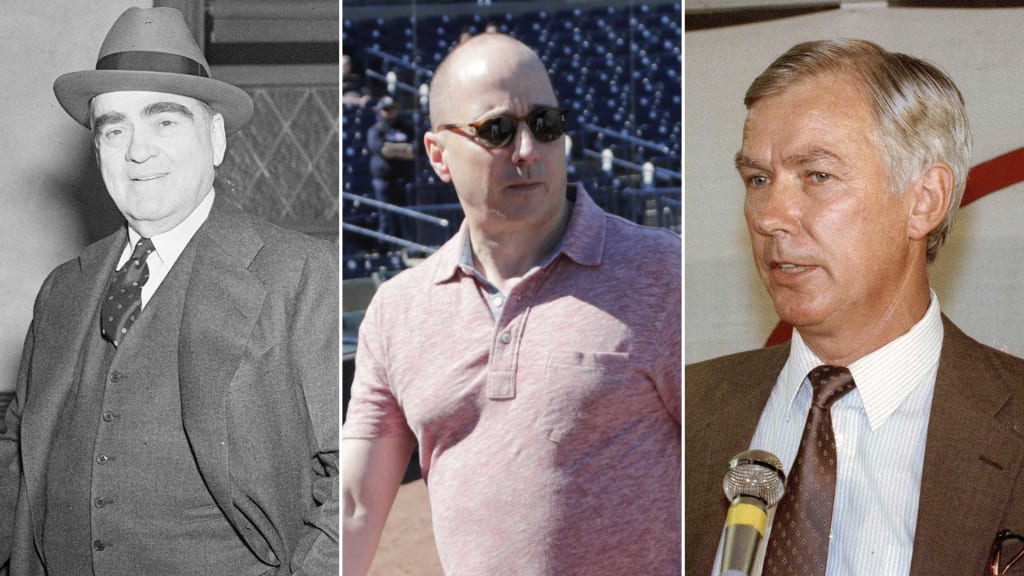
No one loves a good debate quite like baseball fans, and with that in mind, we asked each of our beat reporters to rank the top five players by position in the history of their franchise, based on their career while playing for that club. These rankings are for fun and debate purposes only … if you don’t agree with the order, participate in the Twitter poll to vote for your favorite at this position.
Here is Bryan Hoch’s ranking of the top five general managers in Yankees history:
1) Ed Barrow, 1920-45
The Yankees might never have earned their mighty reputation if not for Barrow, who worked diligently behind the scenes to orchestrate the dynasties that fitted Babe Ruth, Lou Gehrig, Earle Combs, Joe DiMaggio, Tony Lazzeri, Red Ruffing and Lefty Gomez for pinstripes -- and, later, resulted in their enshrinement in the National Baseball Hall of Fame.
Barrow eventually joined those all-time greats in Cooperstown’s hallowed hallways, honored for the striking trades and purchases that resulted in 14 American League pennants and 10 World Series championships during his quarter-century in the front office, including five sweeps of the Fall Classic.
“I say there has never been a smarter baseball man than Mr. Barrow,” the Dodgers’ legendary Branch Rickey once said. “He knows what a club needs to achieve balance, what a club needs to become a pennant winner. I, perhaps, can judge the part, but Mr. Barrow can judge the whole.”
Barrow was part of the Red Sox front office in 1920, when the financially strapped franchise sold Ruth in a shortsighted move they would regret for generations. Barrow soon followed the Bambino to New York, becoming the chief executive under owner Jacob Ruppert, whose willingness to write large checks complemented Barrow’s aggressive and bold tactics.
In addition to talent in scouting -- for example, Barrow ignored a DiMaggio knee injury and offered the prospect a $25,000 bonus in 1934 -- he was the driving force behind the completion of the original Yankee Stadium and established Gehrig’s No. 4 as the first retired number in baseball history. Barrow is also credited with permitting fans to keep foul balls and pioneered the playing of "The Star-Spangled Banner" before each game.
2) Brian Cashman, 1998-present
Having turned a summer internship at age 19 into more than two decades thriving in one of the most challenging chairs in professional sports, one might be tempted to describe Cashman’s rise as one toward a dream job. In truth, becoming the Yankees’ GM was an assignment that Cashman never envisioned -- and when the title was initially offered to him in February 1998, his first instinct was to sprint in the other direction.
Beginning in 1986, Cashman saw his predecessors struggle with the stressful demands of taking orders from principal owner George M. Steinbrenner, remarking on numerous occasions that he would “never want that job.” Cashman’s turn came when Bob Watson resigned following the 1997 season. Steinbrenner decided to promote the then-30-year-old, who had started out by working days in the baseball operations department and evenings with the Yankee Stadium security team.
“I always thought it would be my first day and the last day on the job, because there was no staying power in the position,” said Cashman, who initially asked Steinbrenner for a one-year deal, rather than the three that The Boss had offered. “But years have gone by, and to use a surfing analogy, I’ve been riding the waves.”
Now baseball’s longest-tenured GM, Cashman has won five World Series rings, including four as GM (1998, ’99, 2000, ’09) -- the only GM since the Dodgers’ Buzzie Bavasi in the 1950s and '60s to win four titles in that role. The youngest GM to win a World Series and the only one to win titles in each of his first three seasons, Cashman’s lifetime winning percentage of .589 is the highest of any GM with at least 10 seasons of experience whose career began in 1950 or later. It’s also the best team winning percentage in the Majors during that same stretch.
Cashman has adapted to numerous changes in the operations of Major League clubs over the years, adding muscle to a player development system that has generated "Baby Bombers" like Aaron Judge, Gary Sánchez and Luis Severino while also sharpening the team’s growing edge in advanced analytics. In all, the Yanks have earned 18 playoff berths under Cashman and have won at least 84 games in all 22 years of his tenure.
“The one thing that you know you’re always going to get from the New York Yankees is excellence,” Cashman said. “We are always trying to be the best team and the last team standing. Practically, it’s impossible to always have that happen, but it’s something that The Boss always projected.”
3) Gene Michael, 1980-81, ‘91-95
A light-hitting infielder who played 10 seasons in the Majors, “Stick” served two stints in the GM’s chair, winning a pennant in 1981 and overseeing another postseason run in ’95. However, Michael’s input proved even more valuable as one of Steinbrenner’s most trusted confidantes, helping the dynasty of the late 1990s materialize by exercising his influence to ensure that Derek Jeter, Mariano Rivera, Bernie Williams and others remained in pinstripes.
Michael wore many hats in the organization, transitioning from player to coach to manager, then GM, then back to the dugout (“Why would you want to stay manager and be second-guessed by me,” Steinbrenner famously told Michael, “when you can come up to the front office and be one of the second-guessers?”).
His second tenure as GM coincided with Steinbrenner being suspended from the club’s baseball operations, and given that rare autonomy, Michael overhauled the mindset to develop budding talent rather than trade it for proven commodities. Through the MLB Draft, free agency and trades, Michael ensured that players like Jeter, Rivera, Williams, Jorge Posada, Paul O’Neill, Tino Martinez and David Cone all had opportunities to flourish in New York.
One example: Michael was an advisor and super-scout during the spring of ’96, when Steinbrenner fretted about Jeter’s fielding. Steinbrenner lobbied to trade Rivera to the Mariners for veteran Felix Fermin, a suggestion that Watson, manager Joe Torre and Cashman furiously rejected. When the soft-spoken Michael also recommended standing pat, his words carried weight, and Steinbrenner eventually grumbled: “You’d better be right.” He usually was.
4) George Weiss, 1947-60
Described on his Hall of Fame plaque as a “master builder of championship clubs,” Weiss was a driving force that saw the Yankees win four straight World Series titles from 1936-39 and five more in a row from 1949-53. Ruppert and Barrow secured Weiss’ services to develop the farm system, which he did for 15 years, feeding the big league roster with talent like Phil Rizzuto, Joe Gordon and Charlie Keller during Joe McCarthy’s reign as the field manager.
Weiss took over as GM following the club’s victory in the 1947 World Series and completed numerous deft trades (including several lopsided deals with the Kansas City A’s, such as the one for Roger Maris), arguably making his best move by hiring Casey Stengel as manager in 1948. Weiss and Stengel celebrated 10 pennants and seven championship titles together, in part due to the emergence of stars like Mickey Mantle and Whitey Ford.
Weiss’ record would have been more impressive had he been open to pursuing African American players; his Yanks passed on Willie Mays in 1949, and the big league roster didn’t integrate until Elston Howard arrived in 1955 -- eight years after Jackie Robinson debuted for the Dodgers.
A four-time recipient of the Sporting News’ Executive of the Year award, Weiss was elected to the Hall of Fame in 1971.
5) Gabe Paul, 1973-77
Part of the syndicate that helped Steinbrenner purchase the franchise from CBS, Paul served as the club’s president and general manager for a pivotal five-year run during which he helped to restore luster after a downtrodden period.
Leaning on his prior experience at the helm of the Reds, Colt .45s and Indians, the “Smiling Cobra” made shrewd trades that imported Chris Chambliss, Bucky Dent, Ed Figueroa, Oscar Gamble, Graig Nettles, Lou Piniella, Willie Randolph and Mickey Rivers, while overseeing the landmark free-agent signings of Jim “Catfish” Hunter and Reggie Jackson.
Paul’s time in the chair came with the challenge of serving as a peacekeeper for the triumvirate of Steinbrenner, manager Billy Martin and Jackson. Paul’s reward for serving as the keeper of the "Bronx Zoo" came in October 1977, when Jackson homered three times in the decisive Game 6 of the World Series, securing the only championship of Paul’s 56 years in the game.

